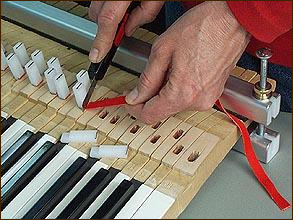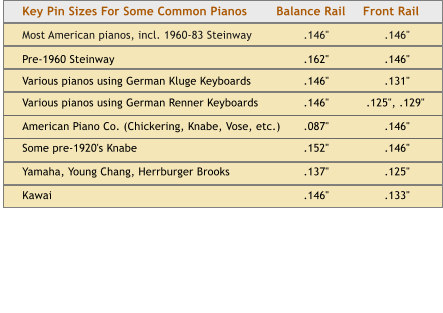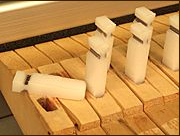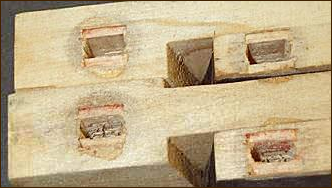Click here to enter keybushing caul online shop!
Polyethylene Key Bushing Cauls 
One of the easiest improvements you can make to a piano is to replace worn key
bushings. The secret to obtaining neat, accurate results is the use of precision bushing cauls that correspond to the key pin size of a given piano. When left in place until the glue hardens, these cauls act as a form, molding the bushings to the correct size and greatly reducing the need for key easing.
Our high density polyethylene key bushing cauls are the most economical on the market. We machine them to ±.001″ tolerances for a wide range of key pin sizes. This material is extremely durable, impervious to glue, and dimensionally stable. All cauls are color coded for size identification.
Caul Thickness: Our stock Final and Double Shouldered cauls are made .002″ larger than the key pin, ±.001″. With proper cloth thickness and gluing, and after leaving the cauls in place 6-8 hours until the glue hardens, these slightly oversized cauls result in keys that need little or no easing. Non-oversized cauls are available on a custom-order basis.
Caul Width: We cut all of our stock caul sizes 11/32″ wide, rather than 3/8″. This narrower width allows these cauls to be used in a much greater range of keys, since many cauls have mortises less than 3/8″ wide (front to back dimension). Custom widths are available by special order.
Single Shoulder vs. Double Shoulder Cauls
Our standard stock sizes include the Single Shoulder types specifically made for the two-caul method of bushing one side of the mortise at a time. In this method, an Intermediate Caul holds the first piece of cloth in place, then a Final Caul is used to clamp the second piece. This method is extremely fast and accurate due to economy of motion and tool usage, as explained in our publication Efficient Key Rebushing. The single shoulder design also allows for making flush cut balance rail bushings, using the flat side of the caul, or shouldered bushings, on front rails or some balance rails, using the shoulder side of the caul. We also manufacture the conventional Double Shoulder Cauls ( the tongue is the same dimensions as Final caul single shoulder) which allows quick re-bushing of the front rail without having to wait for one side to dry first. Simply bush one side and when you finish key 88, go back and start the other side immediately with the double shoulder final caul. Some people also use Double Shoulder cauls to bush both sides at once, although we don’t recommend this method as it is slower and wasteful.




Since the desired result of key rebushing is properly sized bushings, efficient work requires enough cauls to clamp all bushings until the glue is fully hardened. The bushings will then be properly sized, with only a minimum of easing required to achieve the final fit. If using a one-caul method, a minimum of 88 cauls will allow bushing one key rail at a time.
For the two caul method, you need at least 45 Intermediates and 90 Finals. You can insert the 45 Intermediates, then pull the first few out and reinsert ahead as you work down the rail. If you do a lot of rebushing it is worthwhile having 90 Intermediates since this will speed up your work. Since the Finals need to stay in place until the glue hardens, you should have 90 of each pin size you are working with. Most pianos have .146″ pins on both rails, so it is most convenient to have 180 of size #2 so both rails can be bushed at one sitting. Packaging & Quantities All bushing caul sizes are sold in boxes of 45 or 90.
Mortise Sizing Cauls

These special cauls further improve the consistency of your bushing jobs by uniformly sizing the key mortises after removal of the old bushings. Just steam or soak out the bushings, insert a Sizing Caul into each mortise while the wood is still damp, and allow to dry. The mortises will then be very evenly sized with smooth, flat sides as shown below. Bushing stability will also be improved because the moisture-swollen wood will be compacted back to its original dimension, not left in a soft, expanded state.
The top two ke ys at left had Mortise Sizing Caulsinserted after bushing removal. The lower two keys were left to dry empty.
ys at left had Mortise Sizing Caulsinserted after bushing removal. The lower two keys were left to dry empty.
We manufacture these special cauls in four sizes:
For keys with .125″ to .133″ pins- use Mortise Sizing Cauls MS-125, sold in boxes of 90
For keys with .146″ to .152″ pins- use Mortise Sizing Cauls MS-146, sold in boxes of 90 or 180
For keys with .137″ pins- Use Mortise Sizing Cauls MS-137, sold in boxes of 90
For keys with .162″ pins- use Mortise Sizing Cauls MS-162, sold in boxes of 90
Note: For .087″ key pins you can use our regular key bushing cauls size #4 or DS-162 as mortise sizing cauls
Note: .137″ pins are often used in balance rails with hard beech key buttons. These mortises do not tend to swell or distort during bushing removal, so mortise sizing may not be beneficial in this instance.
Tip: Since many pianos have .146″ pins on both rails, you will probably want to have 180 of the MS-146. But .125″, .131″, .133″ & .162″ pins are found on only one rail, so you will only need 90 of the MS-125 and MS-162
